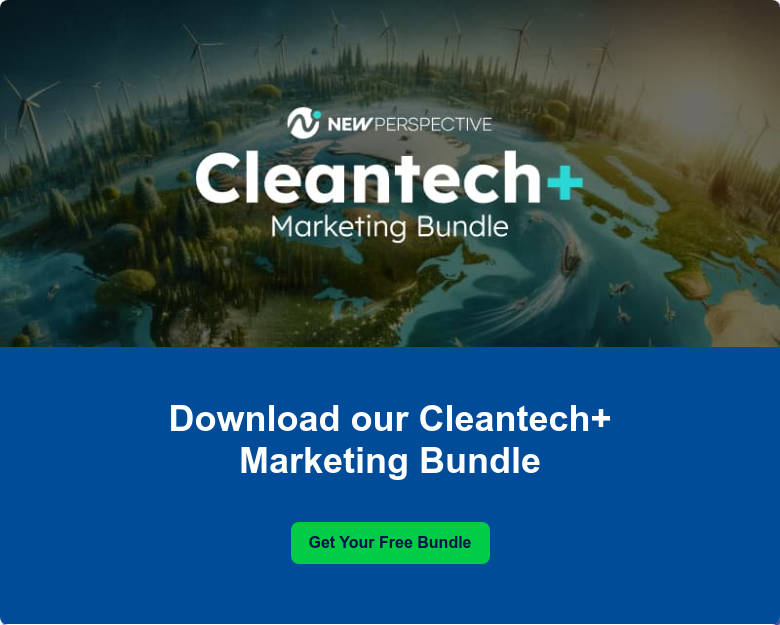3 Effective Strategies for Cleantech Lead Generation

If you’re in cleantech, congratulations: You’re in one of the fastest growing economic sectors right now. Valued at $10.32 billion in 2020, the global green technology and sustainability market size is projected to grow to about 7X that size $74.64 billion — by 2030.
Like any other business, B2B cleantech firms need leads — high-quality, good-fit leads, and as many as possible (though quality is always better than quantity). But cleantech is a unique space, packed with mission-driven innovations and the need to reach a growing audience.
Further, with the industry booming and evolving at a fast pace, you need to offer great content that achieves maximum reach within an expedient timeline.
- From where we stand, these pain points often stand in the way of cleantech lead generation:
- The targeting has to be hyper-specific, which can stretch advertising budgets beyond their usual limits.
- The sales cycle tends to be more involved and take longer than in other industries.
- The level of information has to be far more granular for professionals to justify exchanging contact information for an asset.
- The content — from websites to blogs to webinars — isn’t set up to capture leads, but just as “informational.”
These are all surmountable challenges if you have the right strategy: you need to put the right content on the right channels, and keep doing it. But here’s another pain point we’re finding: Particularly with fast-growing cleantech companies, there may not be a depth of knowledge regarding the importance and dynamics of lead generation.
You’ve built your company based on something potentially world changing. Now it’s time to focus on getting that hard work out into the world —and build the lead generation critical for your growth. Read on.
The strategic cornerstones of successful cleantech lead generation
Lead generation isn’t a magical process. It’s a clearcut system with definite objectives:
Collect prospect information
A great email list is an invaluable asset in any business. Having huge followings on social media and views on PPC ads can only take you so far. At some point, you need to bring qualified prospects into your system so you can nurture and close sales.
Start at the top of the funnel
Lead gen is a top-of-funnel (TOFU) function, when customers are starting to research solutions to their problems and are looking for information. Your role at this phase is to agitate their pain points so they realize that yes, they really do have a problem on their hands. Then, collect their contact information with the promise of alleviating those pain points.
Trade wisdom and information for contacts
Content marketing is one of the foundations of a good lead gen strategy. People need information and guidance; you offer them in exchange for contact details.
Qualify leads early and often
Employing technology tools to help with nurturing and lead scoring are imperative for qualifying and nurturing the best leads — meaning leads that are worth the effort of pursuing. You don’t want to waste your sales team’s time and energy: they need to focus on active and qualified buyers, as soon as they can.
The best content for generating leads in the cleantech industry
Given these objectives, we’re going to dive into three forms of content we recommend right now for cleantech B2B companies, and how to maximize each one’s power.
You can reach more of your target audience with your unique information and guidance if you cover the bases with more than one kind of content. By creating smart content that people want to engage with, you can position yourself as a leader in the cleantech industry.
Your own website
Yes: your website is both a content channel and content itself. It’s got tremendous potential, and most companies don’t know what their own website is capable of. Consider that 80% of potential buyers research a company online before they make a purchase, whether B2C or B2B.
A company’s website can be a phenomenal engine of lead generation if it’s strategically built — or rebuilt — or even just revamped. But we see too many websites that look like a series of pages, piled together with no real connection to the target audience or to how to generate leads and traffic.
Key steps to take:
1. Identify your audience
Who are they? Understand their pain points, questions, and problems they need solved. Create some representative personas and get inside their heads.
2. Look at your website
From your landing page and pillar pages to your services, resources, about, and more, does each component address the needs of your target audience?
Put yourself in a persona’s shoes and navigate the site.
What’s missing, what’s there? Big question: Is it all up to date?
3. Build pillar pages
Your website needs to have pages devoted to specific topics to reach people the way they search — which is often using strings of words. A recent study of search behaviors found that 64% of searchers use strings of 4 words or more.
A pillar page is a savvy way to get found, including everything there is to know about a topic — and also providing links to more information in detailed blogs (which in turn link back to the pillar page).
4. Install CTAs and contact forms everywhere
You’re not going to get prospects if you don’t have a way to contact them. So make sure every page has a CTA (call to action) that invites visitors to provide their contact information and:
- ask questions and get answers
- talk to a person about working together
- learn more about a topic
- get on a valuable email list
We recommend short, sweet, and well-phrased. Don’t give a mini lecture and then say “for more on this…”. The prospect will already be gone.
5. Measure performance
Take a hard look at your website traffic and stats to find the strengths and weaknesses.
- What pages generate the most / the least traffic?
- What features bring in the most / the least leads?
- What calls to action (CTAs) are pulling in the most prospects?
Pay particular attention to your resources / blog page. What blogs are getting the most attention / the least ? (Tip: it’s as important to know what doesn’t get attention as what does.)
6. Get to work
Commit to seeing your website as responsive, growing, flexible, and always improvable. We’ve seen what happens when clients suddenly shift to that approach. It’s like a wall comes down — and the website becomes an asset, not just a chore. With the information you’ve gleaned via due diligence, start making fixes.
Set a plan to address the weakest spots and make improvements, step by step. Remember: everything on your website is a form of content. Make it work for you.
7. Check and re-check
To transform your website from a static entity that just happens to be online to a content-driven, dynamic lead machine takes constant effort. Keep tabs on traffic and hits. Run analytics frequently and act on them.
And keep up with your company’s own evolution and news. Nothing is more disengaging than a website that is obviously lagging behind.
Dive in and learn more
We’ve seen clients go from ho-hum on their website to absolutely driven to harness its power and pull in lead after lead. Often it’s a matter of learning all you can and gaining confidence in your website strategy. Learn how we create growth-driven websites that really work in cleantech. Then take a look at our instant website grader.

Blogs
You may not see a blog as capable of generating leads. But blogs are content heroes that can do a lot of heavy lifting — and achieve a whole range of different goals. In information-hungry cleantech, content is a superhero. Most companies are looking for granular information that is highly relevant to what they’re doing.
In terms of lead generation, the occasion of a blog gives an opportunity to promote across multiple channels. Blogs that present meaningful information that matters give people a reason to stay on your site longer.
Rich with great searchable keywords (hint), they help you ace SEO. No surprise that B2B marketers who use blogs gain more 67% more leads over those who don’t.
Key steps to take:
1. Make a blog game plan
We agree: “content” is a pretty nebulous word. And “blog” used to be a verb for someone that wrote off the cuff about all sorts of happenings.
But today’s blogs now come in many shapes and sizes: and the best ones are packed with information and light on fluff. We also strongly recommend creating a plan with different kinds of blogs to engage your audience, such as:
- Debunking industry myths and explaining industry terms
- Spotlighting innovations and trends in the industry
- Explaining regulatory changes important to the industry
- Discussing industry reports
- Providing case studies related to your product or service (how it solved specific problems, etc.)
- Thought leadership blog on a key topic bylined by one of your company execs (not just an opinion piece, but a well-considered dive into the subject).
- Updated blogs that have already been published but get new attention to increase traffic and audience.
2. Build a blog team
We understand firsthand how complicated blogs can get. You can’t just assign your CEO to write a blog in her spare time. But you can designate the subject matter experts in your organization who are interested in having a say.
Then get a team to help them say it — take it from napkin notes, an outline, or a draft to the finished product. A team works better than one individual for a dozen reasons, including time. Blogs take time.
The tasks involved include:
- Research
- Brainstorming
- Outlining
- Drafting
- Editing
- Polishing
- SEO
How you handle each element is up to you. But the bottom line is you’re going to need people with skills to carry it off.
Treat this as an ongoing project with key objectives — the most central being generating leads. The more you can commit to it, the better results you’ll have.
3. Create a publishing cadence
As far as how many pieces can you publish on your own blog site, start with a do-able strategy. You can always increase the pace. Smaller organizations are not going to have the resources to post all the time.
Instead, figure out what you can do. If your goal is to increase brand awareness, you can post once or twice a week, and keep the content varied. But if your goal is to push organic traffic, you’re going to need to post more frequently.
HubSpot data found that B2Bs that publish at least 11 blogs a month get three times as much traffic as companies that just publish once a month.
4. Reach out to cleantech trade publications
Trade publications contain an almost unparalleled air of credibility and authority. They also connect you to a large potential target audience via their readership), and put your thought leadership in good company with other thought leadership.
Scope out the right clean tech trade publications that fit your industry and your objective, such as Greentech Media, PV Magazine, and Renewable Energy World.
Check their publishing guidelines regarding style and hyperlinks — here’s an example — so your piece isn’t rejected out of turn. Some publications want a pitch first, so you don’t have to allocate the time and resources to write a piece until they accept the pitch.
5. Update your existing blogs
It’s considered a best practice to take old blogs that have been sitting on your website and update them with new headlines, more recent data, and other changes. You don’t need to literally rewrite them start to finish. You’re changing elements to rejuvenate their searchable key words and refresh their ranking.
6. Craft inviting calls to action (CTAs)
While a call to action (CTA) on a website may be simply a button that directs the user to take a specific action, on blogs they need to be a bit more subdued. Write a clear, simple invitation to learn more, discover more, explore more, reach out to someone.
Don’t make it too long, and don’t forget what topic the blog just covered (generic calls to action can be turnoffs). The goal is to get a name and an email address you can add to your database.
Webinars
Webinars can be a powerful source of leads, delivering a targeted audience that wants to stay on top of industry information and trends, learn more about a specific technology that overlaps with your product, or even digest in-depth demos of your solution.
They’re worth the planning: webinars with 100 to 199 registrants have a live attendance rate of 51%, and the average registrant to attendee conversion rate is as much as 55%.
The following steps apply to all kinds of industries — and will give cleantech firms an edge. One reason: this is a field where new innovations and changes happen at a very fast pace, and your audience needs to stay on top of the transformations. Webinars are a great way to present a lot of information and wisdom in an inviting, accessible format.
Key steps to take:
1. Plan a webinar cadence
Unlike blogs, we feel that the first step is actually managing your time in the case of webinars. Be realistic about how many webinars you can host and/or participate in over the course of the year. The tasks involved in producing a webinar can take hours over the course of weeks, and cover everything from content planning and creating the talking points and slides to social media promotion and marketing and sales follow-up.
Depending on the topic, you’ll have to do some industry research (audiences love data and numbers). You may want to invite a subject matter expert (SME) to be part of the conversation. If you’re doing a webinar a month, that’s going to be a nonstop push, so keep that in mind.
2. Designate a webinar team
Whether you’re working with an outside team or not, make sure there’s a team in place who can accomplish the objectives involved.
The skeleton list of tasks includes:
- Topic selection / research / content writing
- Speaker and guest speaker selection
- Scheduling
- Promotion
- Slide design
- Registration page content and banner
- Social media
- Hashtags for promotion
- Invitations
- Webinar production
- Run-through
- Webinar broadcast
- Lead follow-up
- Publish webinar on-demand online
3. Follow webinars best practices
Webinars are a unique combination of content and event — and both aspects have to be carefully tended to.
Five tips on great webinar content:
- Make sure the wisdom you’re offering really meets the needs of your target audience (which means know your target audience).
- Give your speaker / speakers a clear structure and clear talking points. Some speakers will prefer the chance to ad-lib on data points and are terrific at connecting the dots. Others will need a whole script in place.
- Align the slide deck to the talking points, but spread the information out over multiple slides. Short, clear and sweet is best. across an attractive slide deck. Don’t overload each slide with too much information or text, and make sure the slides line up with the speaker’s approach.
- Consider including pulse surveys (if they apply, such as for a webinar on industry trends) throughout, and a Q&A section at the end. Webinar audiences love to participate. You could seed questions (with planned answers) at the end as well if you think you may not get many questions in.
- Don’t waste the wisdom! Build recap blogs and infographics from some of the webinar content, and then include CTAs to check out the webinar with them.
Five tips on great event planning:
- Even though the webinar will live on as an on-demand offering, treat the webinar as a special event.
- Do plenty of promotion before the webinar, driving traffic to the webinar’s registration page.
- During the webinar, consider live-tweeting and other social media postings as it’s happening using relevant hashtags.
- After the webinar, reach out to all guests and thank them for coming, inviting them to learn more.
- Assess the success of the event and apply learned lessons to the next webinar in the series.
Content + leads = growth
Each of these three content forms can function as its own lead generation magnet. Websites are gold mines often untapped by businesses — but once you make the shift to seeing a website as a dynamic, strategic marketing machine instead of just a series of informative pages, you’ll see the results in terms of traffic and engagement.
Blogs can not only be created by updated to maximize their ranking in search — and if you conclude each one with a compelling CTA you’re seizing a great opportunity to build your audience and your leads. Webinars have been even more popular since the pandemic: since the beginning of COVID-19, attendance soared by 87%.
For cleantech industry, all three can make an enormous difference in putting your thought leadership, product, service, and brand on the map — and finding the leads you need to keep growing. If you’re looking for a great partner for creating content, attracting new leads and growing your cleantech business, contact us.




